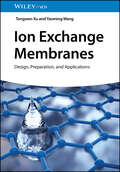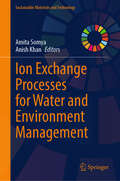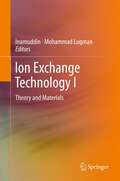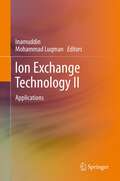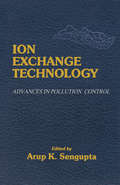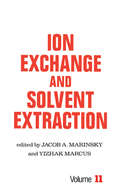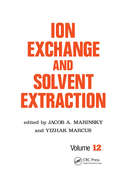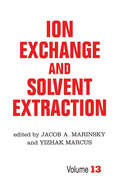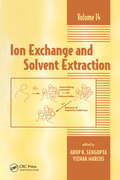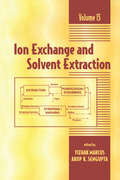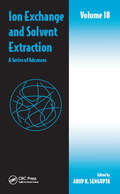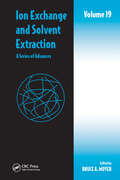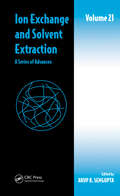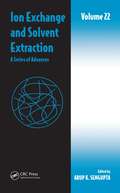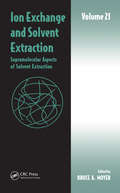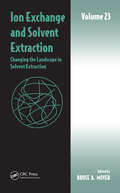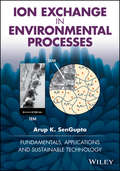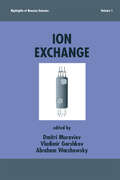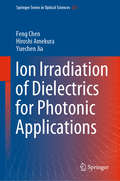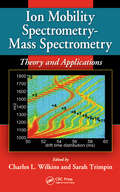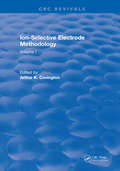- Table View
- List View
Ion Exchange Membranes: Design, Preparation, and Applications
by Tongwen Xu Yaoming WangIon Exchange Membranes A comprehensive introduction to the electro-membrane technologies of the future An ion exchange membrane is a polymer-based membrane which can be permeable by some ions in a solution while blocking others, making them ideal for processes such as water desalination, salt concentration control, clean production and—given their electrical conductivity—power generation and energy storage etc. Recent advances have given rise to new electro-membrane processes that promise drastically to expand the applications of this technology. Scientists in both research and industry will increasingly need to draw on these membranes in vital ways with strongly positive potential environmental impact. Ion Exchange Membranes summarizes recent research into these membranes and electro-membrane processes before moving to an overview of the historical background. It then attends in detail to cutting-edge fabrication technologies and the most recent areas of use. The result is a comprehensive introduction to the design, fabrication, and applications of these increasingly essential membranes. Ion Exchange Membranes readers will also find: In-depth treatment of industrial-scale applications Detailed discussion of topics including side-chain engineering, polyacylation, superacid-catalyst polymerization, and more Analysis of electro-membrane processes such as alkaline membrane water electrolysis, solar-driven water splitting, and many more Ion Exchange Membranes is ideal for membrane scientists, materials scientists, inorganic chemists, polymer chemists, and researchers and engineers in a variety of fields working with ion exchange membranes and electro-membrane processes.
Ion Exchange Processes for Water and Environment Management (Sustainable Materials and Technology)
by Anish Khan Amita SomyaThis book presents theory, principles and applications of ion exchangers for water and environment management. It begins with an introduction, ion-exchange equilibrium kinetics of ion-exchange process and fundamental properties of ion exchangers which make them appropriate in various applications. The theories underlying the operation of ion-exchange resins are explained, as well as the production of resin products with groups adapted to specific ions or groups of ions including principles of ion-exchange process, different synthetic procedures of ion exchangers and characterization techniques, and the role of ion exchangers with their specific characteristics. This book is an invaluable tool to analytical chemists and researchers who are interested in the applications of ion-exchange materials.
Ion Exchange Technology I
by Mohammad Luqman Inamuddin Dr.Ion-exchange Technology I: Theory and Materials describes the theoretical principles of ion-exchange processes. More specifically, this volume focuses on the synthesis, characterization, and modelling of ion-exchange materials and their associated kinetics and equilibria. This title is a highly valuable source not only to postgraduate students and researchers but also to industrial R&D specialists in chemistry, chemical, and biochemical technology as well as to engineers and industrialists.
Ion Exchange Technology II
by Dr Inamuddin Mohammad LuqmanIon-exchange Technology II: Applications presents an overview of the numerous industrial applications of ion-exchange materials. In particular, this volume focuses on the use of ion-exchange materials in various fields including chemical and biochemical separations, water purification, biomedical science, toxic metal recovery and concentration, waste water treatment, catalysis, alcohol beverage, sugar and milk technologies, pharmaceuticals industry and metallurgical industries. This title is a highly valuable source not only to postgraduate students and researchers but also to industrial R&D specialists in chemistry, chemical, and biochemical technology as well as to engineers and industrialists.
Ion Exchange Technology: Advances in Pollution Control
by Arup K. SenGuptaThis book provides comprehensive coverage of developments in ion exchange areas which would continue to have major impacts in the general pursuit of pollution control and pollution prevention. Its nine chapters can be split into four different theme areas: trace contaminants removals; new materials; desalination and finally controlling gaseous pollutants. This would have value for practicing engineers, scientists and researchers who are pertaining to ion exchange technology. It would also server the needs of those trying to explore and identify new technologies in the areas of pollution control and pollution prevention.
Ion Exchange and Solvent Extraction: A Series of Advances, Volume 11 (Ion Exchange And Solvent Extraction Ser. #11)
by Yizhak Marcus Jacob A. MarinskyThe Ion Exchange and Solvent Extraction series treats ion exchange and solvent extraction both as discrete topics and as a unified, multidisciplinary study - presenting new insights for researchers in many chemical and related field. Containing current knowledge and results in ion exchange, this text: presents an overview of the chemical thermodynamics of cation-exchange reactions, with particular emphasis placed on liquid-phase- and solid-phase-activity coefficient models; describes the development of surface complexation theory and its application to the ion exchange phenomenon; discusses metal-natural colloid surface reactions and their consideration by surface complexation modelling complements; and covers the influence of humic substances on the uptake of metal ions by naturally occurring materials.
Ion Exchange and Solvent Extraction: A Series of Advances, Volume 12 (Ion Exchange And Solvent Extraction Ser. #13)
by Jacob A. MarinskyThe Ion Exchange and Solvent Extraction series treats ion exchange and solvent extraction both as discrete topics and as a unified, multidisciplinary study - presenting new insights for researchers in many chemical and related fields.;Volume 12 contains coverage of: the nature of metal-ion interaction with oppositely charged sites of ion exchangers; high-pressure ion exchange separation of rare earth elements; the commercial recovery of valuable minerals from seawater and brines by ion exchange and sorption; the kinetics of ion exchange in heterogenous systems; the ion-exchange equilibria of amino acids; and more.;The work is intended for analytical, co-ordination, process, separation, surface, organic, inorganic, physical and environmental chemists, geochemists, electrochemists, radiochemists, biochemists, biophysicists, hydrometallurgists, membrane researchers and chemical engineers.
Ion Exchange and Solvent Extraction: A Series of Advances, Volume 13 (Ion Exchange And Solvent Extraction Ser.)
by Jacob A. Marinsky; Yizhak Marcus"Volume 13 of this important series continues in the tradition of its widely received predecessors, presenting current advances and results in solvent extraction. Contains nearly 800 helpful drawings, tables, equations and bibliographic citations."
Ion Exchange and Solvent Extraction: A Series of Advances, Volume 14
by Yizhak Marcus Arup K. SenGupta Jacob A. MarinskyThis text introduces a special class of polymeric ligand exchanger (PLE) with high affinities for anionic ligands. Volume 14 discusses the potential and advantages of micro- and nanofiltration membrane processes for removal of metals; details prevailing equilibrium relationships and supporting experimental data for systems where leaching and ion ex
Ion Exchange and Solvent Extraction: A Series of Advances, Volume 15 (Ion Exchange and Solvent Extraction Series)
by Yizhak Marcus Arup K. SenGupta Jacob A. Marinsky"Contains a complete manual with procedures for the implementation and scaling-up of industrial extraction processes. Discusses computer-aided molecular design. Includes examples of interactive, combinatorial, construct-and-test, and mathematical programming."
Ion Exchange and Solvent Extraction: A Series of Advances, Volume 16 (Ion Exchange and Solvent Extraction Series #Vol. 16)
by Yizhak Marcus Arup K. SenGupta Jacob A. MarinskyReflecting the sustained and diverse experimental momentum in the field of ion exchange, Volume 16 summarizes revolutionary advances on par with the consistently high-level research related by this series. This text discusses the kinetics, theoretical models, experimental results/supporting data, and applications for isothermal supersaturation, met
Ion Exchange and Solvent Extraction: A Series of Advances, Volume 17 (Ion Exchange and Solvent Extraction Series)
by Yizhak Marcus Arup K. SenGupta Jacob A. MarinskyVolume 17 in the Ion Exchange and Solvent Extraction series represents the vanguard of research on solvent extraction. It covers the principles of electrolyte extraction and other subjects of increasing interest to the field. This volume begins with pharmaceutical applications of supercritical fluid solvents, particularly supercritical carbon dioxi
Ion Exchange and Solvent Extraction: A Series of Advances, Volume 18 (Ion Exchange And Solvent Extraction Ser.)
by Arup K. SenGuptaAlternating the focus of the series each year, the new volume in the Ion Exchange and Solvent Extraction series represents the vanguard of research in ion exchange. Ion Exchange and Solvent Extraction: A Series of Advances, Volume 18 reflects the remarkable breadth of applications inspiring the latest advances, featuring carefully selected contribu
Ion Exchange and Solvent Extraction: A Series of Advances, Volume 19 (Ion Exchange and Solvent Extraction Series)
by Bruíea. MoyerThe growth in the world's nuclear industry, motivated by peaking world oil supplies, concerns about the greenhouse effect, and domestic needs for energy independence, has resulted in a heightened focus on the need for next-generation nuclear fuel-cycle technologies. Ion Exchange and Solvent Extraction: A Series of Advances, Volume 19 provides a com
Ion Exchange and Solvent Extraction: A Series of Advances, Volume 20 (Ion Exchange and Solvent Extraction Series)
by Arup K. SenguptaOver the past four decades, notable advancements in the theory and application of ion exchange science uncovered a wealth of knowledge that fueled new scientific pursuits and created synergies with myriad scientific endeavors. Today, pioneers continue to break new ground by synthesizing novel materials and merging the interdisciplinary fields of sc
Ion Exchange and Solvent Extraction: A Series of Advances, Volume 22 (Ion Exchange and Solvent Extraction Series #Vol. 16)
by Arup K. SenguptaSince the Second World War, the field of ion exchange has taken a dominant role in offering solutions to many problems in the developed and developing world. It has evolved to a wide array of applications, including mining, microelectronics, drug delivery and detection, food, fertilizers, chemical cleaning, catalysis, bioseparation, water management, environmental research and practices, and energy. The six chapters in this book represent diverse contributions from researchers around the globe who are making noticeable strides in the field in currently important areas: Brackish water desalination Removing boron from water Sustainable approaches for synthesizing commercially important epoxide building blocks Solid-phase heavy-metal separation Separating concentrated ion mixtures in sorption columns Sensing toxic metals Ion Exchange and Solvent Extraction: A Series of Advances, Volume 22 provides a focused review of new materials and new processes that have developed and are rapidly growing. It describes cutting-edge research and practices in the use of ion exchange for building a cleaner, sustainable world and provides thoughtful insights on what ion exchange may do for us in the future.
Ion Exchange and Solvent Extraction: Volume 21, Supramolecular Aspects of Solvent Extraction
by Bruce A. MoyerOver the past several decades, the theme of supramolecular chemistry (SC) has permeated nearly all aspects of chemical endeavor. Not surprisingly, it has also pervaded the field of solvent extraction (SX), inspiring the framework for this volume of Ion Exchange and Solvent Extraction. In addition, tools for studying aggregation have grown increasin
Ion Exchange and Solvent Extraction: Volume 23, Changing the Landscape in Solvent Extraction (Ion Exchange and Solvent Extraction Series #23)
by Bruce A MoyerThis volume will capture transformational changes in both the chemistry and engineering side of solvent extraction, creating new directions and deepening our understanding of the structure and dynamics of liquid-liquid systems from the molecular- to nano- to meso- to bulk-scale. Reviews will cover advances in microfluidics, new tools for understanding the structure and dynamics of the liquid-liquid interface, ionic liquids in liquid-liquid extraction, molecular dynamics to visualize interactions in the solvent phase, liquid-liquid electrochemistry to interrogate the energetics of interfacial transport and complexation, design of new extractants, and the streamlining of process applications.
Ion Exchange in Environmental Processes: Fundamentals, Applications and Sustainable Technology
by Arup K. SenguptaProvides a comprehensive introduction to ion exchange for beginners and in-depth coverage of the latest advances for those already in the field As environmental and energy related regulations have grown, ion exchange has assumed a dominant role in offering solutions to many concurrent problems both in the developed and the developing world. Written by an internationally acknowledged leader in ion exchange research and innovation, Ion Exchange: in Environmental Processes is both a comprehensive introduction to the science behind ion exchange and an expert assessment of the latest ion exchange technologies. Its purpose is to provide a valuable reference and learning tool for virtually anyone working in ion exchange or interested in becoming involved in that incredibly fertile field. Written for beginners as well as those already working the in the field, Dr. SenGupta provides stepwise coverage, advancing from ion exchange fundamentals to trace ion exchange through the emerging area of hybrid ion exchange nanotechnology (or polymeric/inorganic ion exchangers). Other topics covered include ion exchange kinetics, sorption and desorption of metals and ligands, solid-phase and gas-phase ion exchange, and more. Connects state-of-the-art innovations in such a way as to help researchers and process scientists get a clear picture of how ion exchange fundamentals can lead to new applications Covers the design of selective or smart ion exchangers for targeted applications—an area of increasing importance—including solid and gas phase ion exchange processes Provides in-depth discussion on intraparticle diffusion controlled kinetics for selective ion exchange Features a chapter devoted to exciting developments in the areas of hybrid ion exchange nanotechnology or polymeric/inorganic ion exchangers Written for those just entering the field of ion exchange as well as those involved in developing the “next big thing” in ion exchange systems, Ion Exchange in Environmental Processes is a valuable resource for students, process engineers, and chemists working in an array of industries, including mining, microelectronics, pharmaceuticals, energy, and wastewater treatment, to name just a few.
Ion Exchange: Highlights Of Russian Science
by Dmitri Muraviev Vladimir Gorshkov Abraham WarshawskyThis text offers the best of ion exchange science conducted in the countries of the former Soviet Union. It reviews the multidisciplinary study at the nexus of physical, organic, inorganic and biological chemistries, and progresses from theoretical fundamentals to practical applications in manufacturing, mineral refining and environmental clean-up. The text examines advances and phenomena observed in ion-exchange systems.
Ion Irradiation of Dielectrics for Photonic Applications (Springer Series in Optical Sciences #231)
by Feng Chen Hiroshi Amekura Yuechen JiaThis book focuses on the fundamentals, technologies and properties of ion irradiation of dielectric materials (e.g. glasses, crystals) with regard to various photonic applications. It introduces readers to diverse ion-beam techniques for the fabrication and modification of micron- or nanoscale photonic structures, including optical waveguides, photonic crystals, and nanoparticle (nano-spheres and nano-rods) systems, and presents state-of-the-art advances in this multi-disciplinary research field, demonstrating the unique capabilities of ion-beam technologies in optical dielectric materials processing. The book discusses in detail the properties of ion-beam processed waveguides, as well as the modification of dielectrics for photonic applications, such as electro-optic modulation, nonlinear frequency conversion, waveguide amplification and lasing. It also explores synthesis and the correlated optical effects of nanoparticles by ion beams, and features examples of successful micro- and nano-photonic devices. Given its breadth of coverage, the book will particularly appeal to readers interested in ion-beam technology, materials science, and integrated optics.
Ion Mobility Spectrometry
by G.A. Eiceman Z. Karpas Herbert H. Hill Jr.Since the turn of the twenty-first century, applications of ion mobility spectrometry (IMS) have diversified, expanding their utility in the military and security spheres and entering the realms of clinical practice and pharmaceutical exploration. Updated and expanded, the third edition of Ion Mobility Spectrometry begins with a comprehensive discu
Ion Mobility Spectrometry - Mass Spectrometry: Theory and Applications
by Charles L. Wilkins Sarah TrimpinThe analytical power of ion mobility spectrometry-mass spectrometry (IMS-MS) instruments is poised to advance this technology from research to analytical laboratories. Exploring these developments at this critical juncture, Ion Mobility Spectrometry-Mass Spectrometry: Theory and Applications covers the tools, techniques, and applications involved when molecular size and shape information is combined with the well-known analytical advantages of high-performance mass spectrometry.One of the Most Exciting Developments in Contemporary Mass SpectrometryAfter presenting an overview chapter and the fundamentals, the book focuses on instrumentation and ionization sources. It describes an ion-mobility-capable quadrupole time-of-flight mass spectrometer, the differential mobility analyzer, a cryogenic-temperature ion mobility mass spectrometer, the atmospheric solids analysis probe method, and laserspray ionization. In the final applications-oriented chapters, the contributors explore how homebuilt and commercial instruments using electrospray ionization and matrix-assisted laser desorption/ionization (MALDI) methods are employed to solve biological and synthetic issues.Harness the Power of IMS-MS for Analyzing Complex SubstancesThis work helps readers unfamiliar with IMS-MS to understand its fundamental theory and practical applications. It also encourages them to investigate the potential analytical uses of IMS-MS and further explore the power of this method. Numerous color figures are included on downloadable resources.
Ion Mobility-Mass Spectrometry: Methods and Protocols (Methods in Molecular Biology #2084)
by Giuseppe Paglia Giuseppe AstaritaThis book focuses on ion mobility-mass spectrometry (IM-MS) and informatics approaches to improve traditional analysis of molecules by providing fundamentals and protocols for exploiting the potential of state-of-the-art IM-MS technology for the most common analytical applications. The chapters have been organized into four parts, each dealing with a particular set of IM-MS applications: 1) metabolomics and lipidomics; 2) proteomics and glycomics; 3) imaging and ambient ionization IM-MS; and 4) bioinformatic solutions for analyzing IM-MS data and deriving CCS values. Written for the highly successful Methods in Molecular Biology series, chapters include introductions to their respective topics, lists of the necessary materials and reagents, step-by-step, readily reproducible laboratory protocols, and tips on troubleshooting and avoiding known pitfalls. Authoritative and practical, Ion Mobility-Mass Spectrometry: Methods and Protocols serves as an ideal resource for scientists delving into the technique's unprecedented analytical advantages, enabling novel qualitative and quantitative applications for the analysis of complex biological samples.
Ion Selective Electrode Method: Volume 1
by A.K. CovingtonThe intention was to produce a book which perforce would never be far from the laboratory, although CRC‘s use of Handbook in another connection precludes our use of that word in the title.
